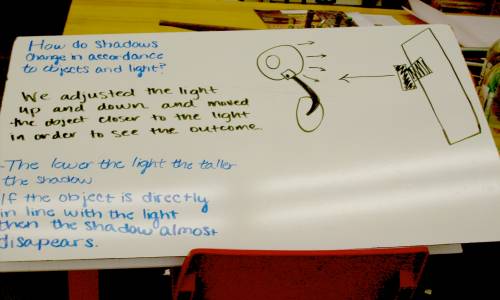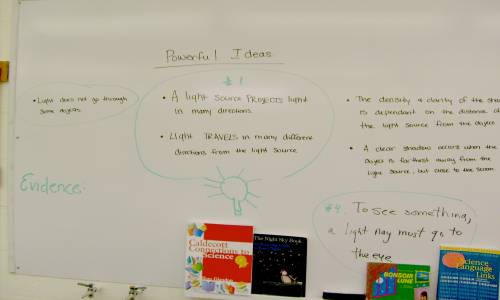You are here: start » activities » light » playingwithshadows » shadowexploration
Exploring Light and Shadow Phenomena
Navigation Links
Light Activities
Playing With Shadows
Sun/Earth/Moon System Phenomena
Introduction:
Place lamp with clear oblong bulb with long filament in front of white board covered with a piece of chart paper (chart paper disperses the light and prevents white board from acting like a mirror).
• How would you describe this light bulb?
•What do you predict you will see when we turn on the light?
• Why do you think that?(some will say light spread all over chart paper, some will predict image of the filament like a mirror).
• What are the ideas that you have just heard expressed? What are the possibilities for what people are expecting to see?
Plug in lamp.
• What do you see? (everyone can see the lit lamp; the light is dispersed all over the chart paper)
Interpret ‘powerful idea’: observation that everyone can see the light and that the light is dispersed all over the chart paper suggests that light left the filament in all directions. Powerful idea: light leaves a light source in all directions.
Activity:
A. Small group discussion:
• What is a shadow?
• What conditions are necessary for a shadow to be formed?
B. Large group discussion:
What is a shadow? What conditions are necessary for a shadow to be formed?
Powerful idea: There are two kinds of shadows:
a) object blocks light from shining on a nearby surface (ground, wall, table…)
b) object blocks light from shining on the back side of the object itself
C. Here is a light source (frosted incandescent lamp), a rectangular object, and screen.
• Where do you think the shadow of the object will appear?
• Draw a diagram that represents your idea about how and where a shadow is formed.
• Turn on lamp. Observe where the shadow is. (use meter stick to trace path from light bulb past obstacle to edge of shadow)
Powerful idea: Light travels in straight lines
Homework:
Distribute piece of cardboard to each student and invite explore at home with friend or family member. What can you find out about shadows?
Make a shadow on the screen that is somewhat larger but the same shape as your board or cardboard cutouts.
Why does the shadow on the screen have the same shape as your board and cutouts?
Can you make the shadow region on the screen larger than the present shadow you have made?
Can you make it the same size? Can you make it much smaller?
(Next class: Each group prepares a presentation on a large whiteboard to present findings to whole group)

